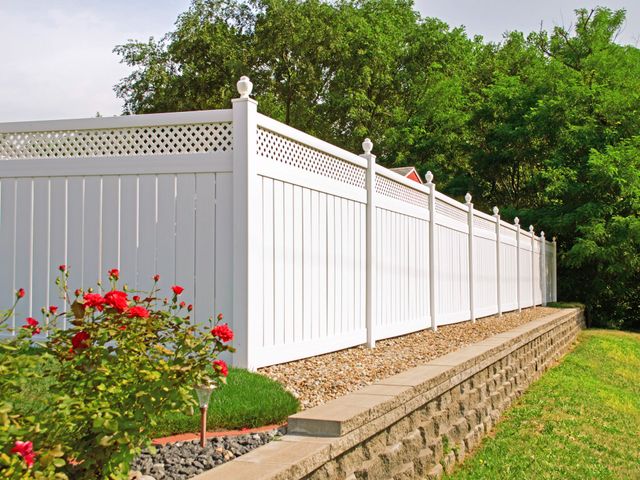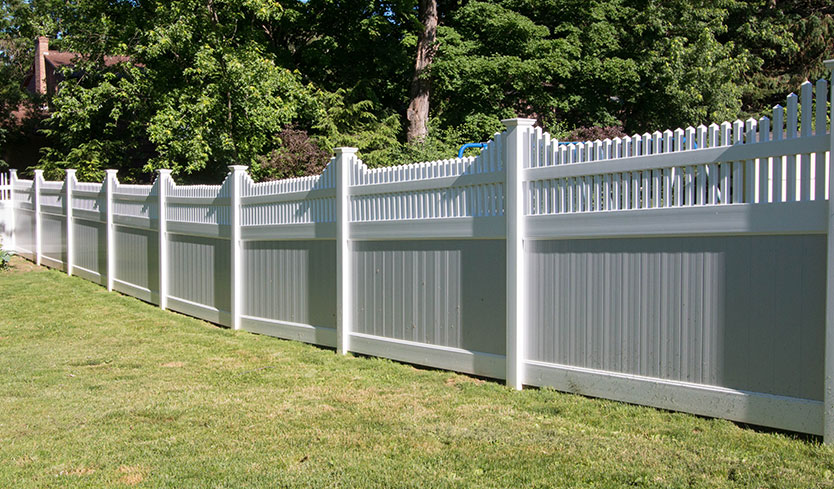Choosing the Perfect Fence Style for Your Property with Help from Gadsden Fence
The Ultimate Checklist for Successful Fence Setup Projects
When you're planning a fence installment job, it's crucial to have a clear method in place. Start by specifying your function and goals, whether it's for privacy or safety and security (Gadsden Fence). Recognizing local policies can save you time and frustrations later on. From there, selecting the right products is necessary for both durability and aesthetics. There's even more to take into account prior to you damage ground. Let's explore the steps that will certainly guarantee your task is a success
Define Your Function and Objectives

Study Local Laws and Permits
How do you guarantee your fence setup goes smoothly? Begin by looking into local policies and licenses. Every location has details regulations concerning fence-- elevation, product, and positioning can differ extensively. Consult your local zoning office or building department to comprehend what's called for in your neighborhood.You might need a license prior to you dig, especially if you're near property lines or utilities. Stopping working to abide by regulations can lead to fines or also having to take down your fence.Also, consider home owners association (HOA) regulations if you reside in a neighborhood with one. They frequently have additional standards that you'll need to comply with.
Choose the Right Materials
When picking products for your fencing, consider durability and how they'll stand up versus the components. You'll additionally intend to strike an equilibrium in between visual appeals and performance to ensure your fence looks terrific while serving its objective. Putting in the time to pick the appropriate products can make all the difference in the durability and look of your fencing.
Material Sturdiness Considerations
As you pick products for your fencing, it's necessary to assess their toughness, given that different options can greatly influence the durability and upkeep of your setup. Wood, while cosmetically pleasing, needs regular therapy to fend off rot and parasites. On the other hand, plastic uses outstanding resistance to fading and breaking yet can be extra pricey upfront. Metal fences, like light weight aluminum or functioned iron, supply stamina and durability, but they may need routine rust protection. Consider your neighborhood environment too; rough climate can affect product performance. Inevitably, selecting the appropriate resilient product will save you time and cash over time, ensuring your fence stands solid versus the elements and lowers upkeep efforts. Select intelligently!
Aesthetic and Useful Balance
While you may focus on toughness when selecting fence materials, attaining an aesthetic and useful equilibrium is similarly crucial. Think of how your option enhances your home's style and the surrounding landscape. As an example, wood fences can provide appeal yet might need even more upkeep, while plastic provides a sleek, modern look with much less upkeep. Steel fences, like wrought iron, can include elegance and security, however make specific they fit the overall vibe of your residential or commercial property. Think about shade, structure, and layout-- these components can boost your aesthetic allure. Constantly maintain your regional climate in mind, as it affects material efficiency. Inevitably, choose products that not only serve their function but also boost your exterior area's visual charm.
Plan Your Fence Design and Format
A strong strategy for your fence design and layout is necessary to assure a successful setup. Start by figuring out the function of your fencing-- whether it's for personal privacy, protection, or aesthetics. Next off, think about the style that enhances your home and landscape. You'll wish to choose products that fit your budget plan and maintenance preferences.Measure your backyard precisely, marking the borders where the fence will go. Consider the height and spacing of the blog posts, guaranteeing they meet neighborhood policies. Sketch a format to picture exactly how your fence will certainly look, taking note of any inclines or challenges. Don't forget to represent entrances for easy access. Seek advice from with your neighbors if the fencing influences shared residential property lines, promoting a good reputation and avoiding conflicts. By carefully preparing your layout and layout, you set the phase for a smooth installation process and a fencing that meets your needs.
Prepare Your Site for Installation
Prior to you start installing your fence, you need to prepare the website. Clear the location of any type of obstacles, see to it you understand your residential or commercial property lines, and inspect neighborhood guidelines to prevent any difficulties. Taking these steps will set a solid structure for your fencing task.
Clear the Location
Cleaning the area is important for a smooth fence installation. Start by removing any obstacles like rocks, debris, or old secure fencing materials. This makes it easier for you and your team to function successfully. Next off, trim any overgrown vegetation, such as shrubs or tree branches, that might hinder the setup process. If you have any kind of exterior furniture or decorations near the fencing line, move those out of the means. This not just avoids damages however also assures your office is safe. Ultimately, take a minute to check for any kind of underground energies. Call your local energy company if you're unclear. A clear, orderly site sets the stage for an effective and hassle-free installation.
Find Building Lines
Recognizing your residential property lines is necessary to confirm your fence is installed properly and legally. Begin by reviewing your building deed, which usually includes a study or map laying out the limits. If you do not have a study, think about working with a professional property surveyor. They'll note the exact lines, assisting you stay clear of conflicts with next-door neighbors. As soon as you've established your borders, use stakes or flags to lay out the area where your fencing will go. try this This visual help not only assists you remain within your limitations yet also supplies a clear reference for your installment. Keep in mind, clear property lines can conserve you from potential lawful issues and neighborly disputes in the future, so put in the time to validate precision before proceeding.

Check Local Regulations
When you have actually developed your home lines, examining neighborhood policies is the next action in preparing your website for installation. Local legislations can determine fencing elevation, products, and even placement. Begin by contacting your regional zoning workplace or seeing their internet site to gather necessary details. Be sure to ask about permits, as many areas need you to get one before you start any type of setup. Additionally, check into any kind of homeowner association (HOA) guidelines that might use in your community. Recognizing these laws upfront can conserve you from possible penalties or the requirement to remove your fence later on. Taking these steps guarantees your fence follows neighborhood criteria and aids you prevent migraines in the future.
Mount Your Fence Effectively
When you're all set to mount your fence, guaranteeing correct placement and deepness is vital for its durability and stability. Beginning by noting the design with stakes and string to envision the fencing line. Make sure your posts are spaced equally, commonly 6 to 8 feet apart, relying on your fence type.Dig post openings at the very least one-third the length of the blog posts, and think about deeper openings for added security, particularly in windy locations. Use gravel near the bottom for drainage and established the articles in concrete, guaranteeing they're degree and plumb.While protecting the panels, maintain them straight and flush with the articles. If you're installing a gateway, verify the measurements to assure it swings openly. After whatever's in area, step back and validate that your fence looks also and professional. Taking the time to set up correctly currently will conserve you headaches later!
Keep Your Fence for Durability
To maintain your fence looking great and standing strong for several years, routine maintenance is crucial (Gadsden Alabama Fence Company). Start by checking your fencing at the very least two times a year. Inspect for any kind he has a good point of signs of damage, such as loose boards or rusted hardware. If you spot concerns, address them immediately to avoid further deterioration.Cleaning your fencing is similarly essential. Remove dirt, debris, and mold with a gentle soap option and a soft brush. For wood fencings, consider applying a sealant or discolor every couple of years to shield versus moisture and UV rays.Don' t forget plant life! Trim back any plants or shrubs that may be leaning versus your fencing, as they can create damage over time.Finally, watch on the ground around your fence. Maintain appropriate drain to stop water pooling, which can weaken the foundation. By complying with these steps, you'll ensure your fence stays stunning and functional for years to find
Frequently Asked Questions
How much time Does a Common Fencing Installation Take?
A common fencing installment generally takes one to 3 days, depending on the size and complexity of the project. You need to consider factors like climate, surface, and the kind of products you're utilizing.

Can I Mount a Fence on a Slope?
Yes, you can install a fence on a slope. You'll need to adjust the fence panels to follow the terrain, guaranteeing stability and appearances. Make certain to plan thoroughly to accomplish the very best results.
What Tools Do I Need for Fence Installation?
For fence installment, you'll need a message hole digger, degree, gauging tape, hammer, saw, and a power drill. Do not neglect safety and security equipment like gloves and goggles to protect on your own throughout the job.
Exactly how Do I Offer With Utility Lines During Installment?
Prior to digging, always call your regional utility companies More Help to situate underground lines. Use an energy locator solution, mark the locations clearly, and avoid excavating within those zones. It'll keep you secure and stop costly problems.
What Is the Typical Price of Fencing Installment?
The typical price of fencing installation differs commonly, usually ranging from $1,500 to $4,000. Variables like materials, labor, and location affect your total expenditures, so it's smart to obtain several quotes prior to making a decision.
Final thought
In recap, by following this supreme list, you can ensure an effective fence installment job that meets your requirements. Specifying your goals, understanding guidelines, choosing the appropriate materials, and preparing your website are all important actions. Once your fencing is installed, continuous upkeep will maintain it looking terrific and functioning well for several years to come - Gadsden Fence. With careful planning and attention to detail, you'll produce a fencing that not just enhances your home yet also offers the personal privacy and safety and security you want